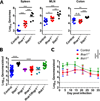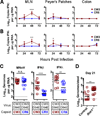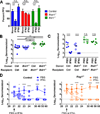Interferon-λ cures persistent murine norovirus infection in the absence of adaptive immunity
- PMID: 25431489
- PMCID: PMC4398891
- DOI: 10.1126/science.1258100
Interferon-λ cures persistent murine norovirus infection in the absence of adaptive immunity
Abstract
Norovirus gastroenteritis is a major public health burden worldwide. Although fecal shedding is important for transmission of enteric viruses, little is known about the immune factors that restrict persistent enteric infection. We report here that although the cytokines interferon-α (IFN-α) and IFN-β prevented the systemic spread of murine norovirus (MNoV), only IFN-λ controlled persistent enteric infection. Infection-dependent induction of IFN-λ was governed by the MNoV capsid protein and correlated with diminished enteric persistence. Treatment of established infection with IFN-λ cured mice in a manner requiring nonhematopoietic cell expression of the IFN-λ receptor, Ifnlr1, and independent of adaptive immunity. These results suggest the therapeutic potential of IFN-λ for curing virus infections in the gastrointestinal tract.
Copyright © 2015, American Association for the Advancement of Science.
Figures




Comment in
-
Immunology. Interfering with interferons.Science. 2015 Jan 16;347(6219):233-4. doi: 10.1126/science.aaa5056. Science. 2015. PMID: 25593173 No abstract available.
Similar articles
-
Expression of Ifnlr1 on Intestinal Epithelial Cells Is Critical to the Antiviral Effects of Interferon Lambda against Norovirus and Reovirus.J Virol. 2017 Mar 13;91(7):e02079-16. doi: 10.1128/JVI.02079-16. Print 2017 Apr 1. J Virol. 2017. PMID: 28077655 Free PMC article.
-
Commensal microbes and interferon-λ determine persistence of enteric murine norovirus infection.Science. 2015 Jan 16;347(6219):266-9. doi: 10.1126/science.1258025. Epub 2014 Nov 27. Science. 2015. PMID: 25431490 Free PMC article.
-
HOIL1 Is Essential for the Induction of Type I and III Interferons by MDA5 and Regulates Persistent Murine Norovirus Infection.J Virol. 2018 Nov 12;92(23):e01368-18. doi: 10.1128/JVI.01368-18. Print 2018 Dec 1. J Virol. 2018. PMID: 30209176 Free PMC article.
-
Norovirus Regulation by Host and Microbe.Trends Mol Med. 2016 Dec;22(12):1047-1059. doi: 10.1016/j.molmed.2016.10.003. Epub 2016 Nov 22. Trends Mol Med. 2016. PMID: 27887808 Free PMC article. Review.
-
Norovirus pathogenesis: mechanisms of persistence and immune evasion in human populations.Immunol Rev. 2008 Oct;225:190-211. doi: 10.1111/j.1600-065X.2008.00680.x. Immunol Rev. 2008. PMID: 18837783 Review.
Cited by
-
IFNL4 Genotype Does Not Associate with CD4 T-Cell Recovery in People Living with Human Immunodeficiency Virus.AIDS Res Hum Retroviruses. 2021 Mar;37(3):184-188. doi: 10.1089/AID.2020.0104. Epub 2020 Nov 11. AIDS Res Hum Retroviruses. 2021. PMID: 33066718 Free PMC article.
-
Gene-disease association with human IFNL locus polymorphisms extends beyond hepatitis C virus infections.Genes Immun. 2016 Jul;17(5):265-75. doi: 10.1038/gene.2016.24. Epub 2016 Jun 9. Genes Immun. 2016. PMID: 27278127 Free PMC article. Review.
-
Interferon-λ at the Center of the Storm.Immunity. 2020 Aug 18;53(2):245-247. doi: 10.1016/j.immuni.2020.07.024. Immunity. 2020. PMID: 32814024 Free PMC article.
-
Gut viruses firm the "Great Wall".Precis Clin Med. 2019 Dec;2(4):209-212. doi: 10.1093/pcmedi/pbz027. Epub 2019 Dec 2. Precis Clin Med. 2019. PMID: 35693878 Free PMC article. No abstract available.
-
Integrative Transcriptomics and Proteomics Analysis Reveals Immune Response Process in Bovine Viral Diarrhea Virus-1-Infected Peripheral Blood Mononuclear Cells.Vet Sci. 2023 Sep 28;10(10):596. doi: 10.3390/vetsci10100596. Vet Sci. 2023. PMID: 37888548 Free PMC article.
References
-
- Phillips G, Tam CC, Rodrigues LC, Lopman B. Prevalence and characteristics of asymptomatic norovirus infection in the community in England. Epidemiol Infect. 2010 Oct;138:1454. - PubMed
-
- Ayukekbong J, et al. Enteric viruses in healthy children in Cameroon: viral load and genotyping of norovirus strains. J Med Virol. 2011 Dec;83:2135. - PubMed
Publication types
MeSH terms
Substances
Grants and funding
LinkOut - more resources
Full Text Sources
Other Literature Sources
Medical

